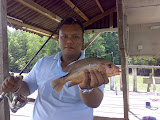LEARND TO JIGGING
Saltwater Fishing with a Jig
Somewhere along the way one of the most versatile fishing lures ever devised received the name "jig". Probably either because the molds they are made from or the mechanism used to hold them while they are being tied, are called jigs. Either way the term has come to mean a particular style of fishing with a particular type of lure - fishing with a jig.
Types of Jigs
Bucktail jigs, nylon jigs, mylar jigs, feathered jigs - they come in all sizes and shapes, and each is designed to imitate a baitfish of some sort. And for fish catching ability, these lures, cast for cast, out fish all other lures. If I had to choose only one lure to fish with, it would be a bucktail jig.
Depth
Jigs work in any depth of water, but generally, the deeper you fish, the heavier the jig.
In water up to 180 feet deep it takes a good 8 ounces of weight to reach the bottom if there is any current at all. These means a jig with a 7/0 or 8/0 hook, and the probability of BIG fish.
Deep Jigging
Any time the water is deeper than 100 feet, the jig fishing I do is called deep jigging. It requires some stamina and a strong back, because it takes a lot of upward motion from your rod to move the jig effectively on the bottom. This is not a place for subtle twitches and jig movements. In water this deep, the line stretch factor removes any possibility for subtleness. What we are looking for here are fast upwards jerks of the rod to get the lure to move up and down in some type of pattern.
Bait Strips
I like to use a strip bait on a deep jig - usually a mullet filet cut thin, pointed on the hook end with a split tail at the end. Too much meat left on the strip restricts the movement of the strip and presents an unnatural looking bait. If we are lucky, we will have caught some small bonito or false albacore, the belly meat of which we always keep. The skin on these bellies is thin and white with a silvery or pearly sheen. This is in sharp contrast to the dark red meat attached to the skin and this contrast works extremely well. Again, the meat side is trimmed very thin to allow that important flexibility.










0 comments:
Post a Comment